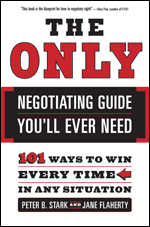Summary: Presenting a problem to a counterpart and challenging him to come up with creative options for a resolution.
This tactic is effective for encouraging your counterpart to come up with creative ways to achieve your goal. You present a challenge that your counterpart needs to help you overcome.
Example
An insurance company’s office supply manager tells a vendor, “I really enjoy working with you and I think your equipment and service are exactly what we need. The problem is, we have a budget of only $150,000 and you have quoted nearly $165,000. What can you do to help us stay within the budget?”



